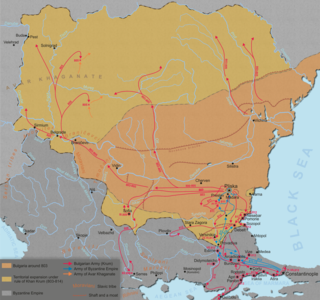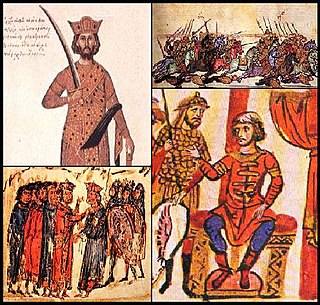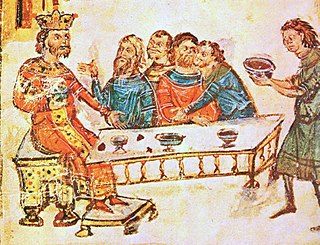The 810s decade ran from January 1, 810, to December 31, 819.

Year 811 (DCCCXI) was a common year starting on Wednesday of the Julian calendar, the 811th year of the Common Era (CE) and Anno Domini (AD) designations, the 811th year of the 1st millennium, the 11th year of the 9th century, and the 2nd year of the 810s decade.

Year 812 (DCCCXII) was a leap year starting on Thursday of the Julian calendar, the 812th year of the Common Era (CE) and Anno Domini (AD) designations, the 812th year of the 1st millennium, the 12th year of the 9th century, and the 3rd year of the 810s decade.

Nikephoros I, also known as Nicephorus I, was Byzantine emperor from 802 to 811. He was General Logothete under Empress Irene, but later overthrew her to seize the throne for himself. Prior to becoming emperor, he was sometimes referred to as "the Logothete" and "Genikos" or "Genicus", in recognition of his previous role as General Logothete.

Michael I Rangabé was Byzantine emperor from 811 to 813. A courtier of Emperor Nikephoros I, he survived the disastrous campaign against the Bulgars and was preferred as imperial successor over Staurakios, who was severely injured. He was proclaimed emperor by Patriarch Nikephoros I of Constantinople on 2 October 811.

Staurakios or Stauracius was the shortest-reigning Byzantine emperor, ruling for 68 days between 26 July and 2 October 811.

Asparuh was а Bulgar khan in the second half of the 7th century and is credited with the establishment of the First Bulgarian Empire in 681.

Omurtag also known as Murtag or Murtagon was a Great Khan (Kanasubigi) of Bulgaria from 814 to 831. He is known as "the Builder".

The Battle of Pliska or Battle of Vărbitsa Pass was a series of battles between troops, gathered from all parts of the Byzantine Empire, led by the Emperor Nicephorus I, and the First Bulgarian Empire, governed by Khan Krum. The Byzantines plundered and burned the Bulgar capital Pliska which gave time for the Bulgarians to block passes in the Balkan Mountains that served as exits out of Bulgaria. The final battle took place on 26 July 811, in some of the passes in the eastern part of the Balkans, most probably the Vărbitsa Pass. There, the Bulgarians used the tactics of ambush and surprise night attacks to effectively trap and immobilize the Byzantine army, thus annihilating almost the whole army, including the Emperor. After the battle, Krum encased the skull of Nicephorus in silver, and used it as a cup for drinking. This is one of the most documented instances of the custom of the skull cup.

The First Bulgarian Empire was a medieval state that existed in Southeastern Europe between the 7th and 11th centuries AD. It was founded in 680–681 after part of the Bulgars, led by Asparuh, moved south to the northeastern Balkans. There they secured Byzantine recognition of their right to settle south of the Danube by defeating – possibly with the help of local South Slavic tribes – the Byzantine army led by Constantine IV. During the 9th and 10th century, Bulgaria at the height of its power spread from the Danube Bend to the Black Sea and from the Dnieper River to the Adriatic Sea and became an important power in the region competing with the Byzantine Empire.

The Battle of Versinikia was a battle fought in 813 between the Byzantine Empire and the Bulgarian Empire, near the city of Adrianople (Edirne), in modern-day Turkey.

The Byzantine–Bulgarian wars were a series of conflicts fought between the Byzantine Empire and Bulgaria which began after the Bulgars conquered parts of the Balkan peninsula after 680 AD. The Byzantine and First Bulgarian Empire continued to clash over the next century with variable success, until the Bulgarians, led by Krum, inflicted a series of crushing defeats on the Byzantines. After Krum died in 814, his son Omurtag negotiated a thirty-year peace treaty. Simeon I had multiple successful campaigns against the Byzantines during his rule from 893 to 927. His son Peter I negotiated another long-lasting peace treaty. His rule was followed by a period of decline of the Bulgarian state.

The siege of Serdica took place in the spring of 809 at modern Sofia, Bulgaria. As a result, the city was annexed to the Bulgarian State and remained so until the fall of the First Bulgarian Empire.
Prokopia was the empress consort of Michael I Rhangabe of the Eastern Roman Empire. She was a daughter of Nikephoros I. The name of her mother is not known. Her only known sibling is Staurakios.

Theophano was the empress consort of Staurakios of the Byzantine Empire. According to the chronicle of Theophanes the Confessor, Theophano was a relative of Irene. Both women were from Athens but the nature of their relation to each other is not known.

The medieval Bulgarian army was the primary military body of the First and the Second Bulgarian Empires, and some Puppet states of the former, like the Despotate of Dobruja. During the first decades after the foundation of the country, the army consisted of a Bulgar cavalry and a Slavic infantry. The core of the Bulgarian army was the heavy cavalry, which consisted of ca. 12,000 heavily armed riders. At its height in the 9th and 10th centuries, it was one of the most formidable military forces in Europe and was feared by its enemies. There are several documented cases of Byzantine commanders abandoning an invasion because of a reluctance to confront the Bulgarian army on its home territory.
The Treaty of 815 was a 30-year peace agreement signed in Constantinople between the Bulgarian Khan Omurtag and the Byzantine Emperor Leo V the Armenian.

The Martyrs of Adrianople, also known and venerated as the 377 Martyred Companions in Bulgaria, were three hundred and seventy seven Christians who were executed in martyrdom in 815. They are commemorated by the Eastern Orthodox Church on 22 January.

The siege of Constantinople in 813 by Khan Krum was a failed attempt to take the city during the Bulgarian-Byzantine wars.





















